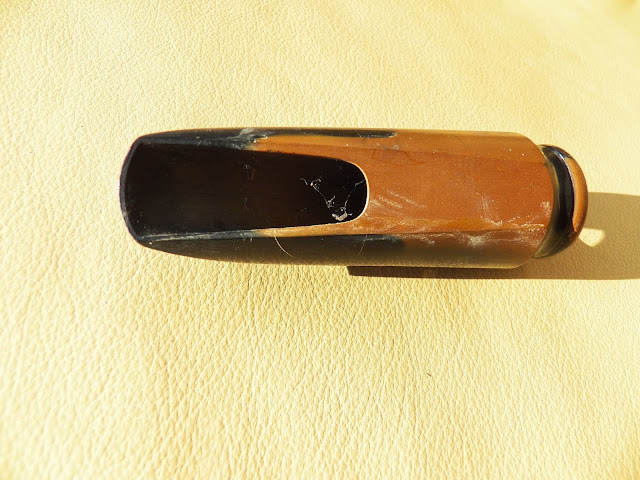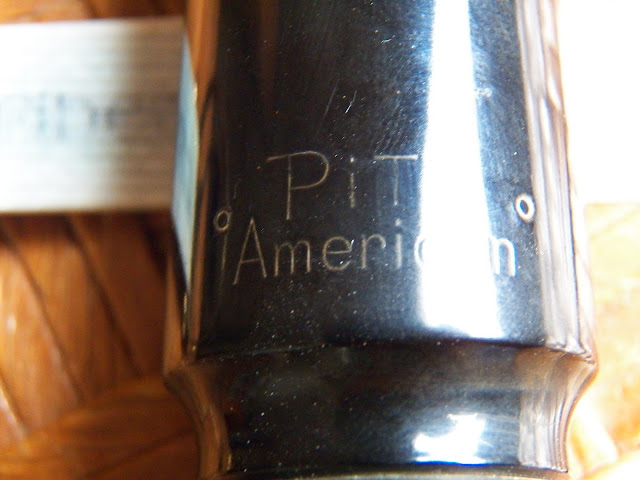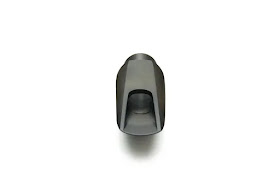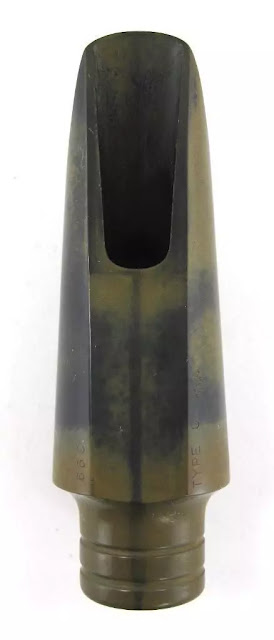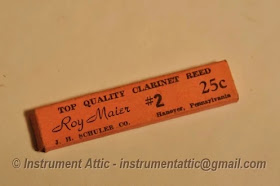I saw that fake Jody Jazz mouthpieces were appearing on Ebay. The text in the Buy-It-Now "auction" was constantly changing. They first appeared as Jody Jazz mouthpieces. Later descriptions said that the mouthpiece was a "JJ" brand, however the name on the mouthpiece was obviously Jody Jazz in the same gold font as the real thing. Some auctions said it was made of hard rubber, others said that it was bakelite. Bakelite (the real name is polyoxybenzylmethylenglycolanhydride)
is a thermosetting phenol formaldehyde resin that is not universally considered "food safe." It might not be something that you would want to put in your mouth every day (or ever). Apparently, the people manufacturing this fake don't know or don't care about what woodwind mouthpieces are made of.
Mine was obviously made in China. In fact, mine was shipped directly from China (although the Ebay store was located in Indonesia). Authentic Jody Jazz mouthpieces are hand finished in the U.S. and, according to their advertisements, are individually played prior to sale by Jody Espina (or somebody at his facility in Savanna, GA). Mine, being shipped directly from China, obviously was going to miss out on this essential quality control.
There were other telltale clues that mine would be a fake. The Jody Jazz HR* sells for about $200 in the U.S. The Ebay Buy-It-Now price was $26. I bought one and was immediately told that it was out of stock and my purchase price was refunded. I went back to the same site, where the price was now $28, and bought it again. Same thing happened. I went back and bought it at $30 and that transaction went through. It appeared that the seller had some kind of automated "sucker pricing" algorithm. That is exactly what one would expect from an Ebay scammer selling knockoff products. The mouthpiece showed up in two weeks with a cheap ligature and cap. Guess what? It was fake!
Although most fake Jody Jazz mouthpieces had disappeared from Ebay by the time I wrote this blog, many other fakes of various brands have recently appeared. Many of them also claim to be made of Bakelite. If you search Ebay for Bakelite saxophone mouthpieces, you may find fake Vandoren, Meyer, etc. Here is a picture of the fake plastic Meyers (falsely claimed to be made of Bakelite, but who cares). Notice that they have faked the current model of Meyer mouthpieces. Don't they know the saxophone lore that the vintage Meyer Brothers mouthpieces magically enhance a player's ability and are therefore worth thousands of dollars?

Late model fake altos.

$26 for a fake Meyer medium chamber. I have no idea what these are made of or what the chamber, lay, etc. looks like. You should not expect that it looks or plays anything like an actual Meyer.
Back to my fake Jody Jazz. Here is what a real Jody Jazz hard rubber HR* looks like. This is a 7 tip (.105 inch). The shank has a smooth "bugle" shape.

Notice that the thickness of the font script is fairly uniform.
Jody Jazz refers to their HR* model as having a medium round chamber. Because the chamber is slightly larger than the shank bore, I would refer to it as a medium large chamber. Here is my "chamber designation" rule for this type of mouthpiece.* If I look in from the tip and see the mold line between chamber and shank, it's large, i.e., the chamber is larger than the shank bore. If I look in from the shank and see the mold line, it's a small chamber. If there is no mold line, i.e., the end of the chamber is the same as the shank bore, it's a medium chamber. That's my test. Probably too simplistic and it's not too important here.

If I can't see the mold line from this direction, that means a large chamber. On these the mold line is very small viewed from the tip (previous picture), hence my calling them a medium large chamber.
Below is the fake Jody Jazz mouthpiece viewed from tip and shank. The view from the tip makes it look like it is a large chamber, but that "line" is just where the chamber drops into the larger shank bore. When viewed from the shank, it is obvious that this is a small chamber not anything like a real Jody Jazz. It is actually similar looking to an old Selmer.

A "pea shooter" style chamber.
We don't have to go into much detail about the differences between a real Jody Jazz HR* mouthpiece and my fake Ebay piece because they are clearly unrelated. First, it didn't even look like the picture used on Ebay (which might have been a picture of a real Jody Jazz mouthpiece).

The shank shape is wrong. The original mass seller has been removed from Ebay (12/2021), but people who bought the $26 plastic knock-offs with this shank shape are now listing theirs (for over $100). Another clue is that real Jodi Jazz mouthpieces came with a Jodi Jazz cap. If no original cap, beware.
The embossing on my mouthpiece was a complete ripoff of the Jody Jazz logo, but was apparently laser etched from directly above. This distorts the font a little.

The logo is distorted because it was printed from directly above. This makes the font lines thicker as it wraps around the mouthpiece, shown here as the start of the "J" is further from the center of the logo.
Second, it isn't Bakelite or hard rubber. It appears to be injection molded ABS (Acrylonitrile Butadiene Styrene), the same plastic used for black plumbing pipe and Legos toys. Is it food safe? Some say yes, some say no. The U.S. Food and Drug Administration stated in 2015 that some ABS formulations are food safe. Is my fake Jody Jazz one of those formulas? I wouldn't bet on it.

The rear edge of the barrel by the table shows the "flash line" common with injection molding. Not Bakelite, not hard rubber.
Here's a better picture of the roughness of the finish and the flash line from the mold on the upper left. I had already taken a few swipes across some course sandpaper to open the tip (and made a note of "71," i.e., .071 inches on the table)
Yes, I put it in my mouth and played it in the name of scientific discovery. I died later that day. Fortunately, I also own a Meyer Brothers mouthpiece that is the Holy Grail. The Holy Grail enabled my corporal resurrection and the completion of this blog.
The fake Jody Jazz played, sort of. In the Ebay advertisement, I had my choice of tip openings. I chose a #7 tip (listed as .105 inches). What I got was about a .060 tip opening. I'm guessing that, no matter what tip opening you request, you would get a .060 tip opening. A lot of players would never measure and so many would never know. They find a mouthpiece that they like and simply assume that the tip opening is related to the embossed number. This fake didn't even have a number (no surprise).
The tiny tip opening on my fake Jody Jazz is okay because the "finish" on the facing curve looked like it was put on with 100 grit sandpaper. There were obvious milling marks on the tip and rails and slightly less, but still visible, marks on the table.
The first thing I did was to flatten the table. As is common with many mouthpieces whether new, old, Chinese, French, whatever, there was a sunken spot right at the top of the window. I suspect that this is a result of the temperature increase resulting from machining the table flat. Fixing it gave me a chance to use a butt cut while flattening.

This is what I'm talking about. A swipe across fine sandpaper shows on the rails, almost to the top of the window, and at the butt end of the table, meaning that in between it is "hollow."
I wiped the above mouthpiece table across 1000 grit sandpaper to show me whether the table was flat. It revealed a high spot before the end of the window and another at the heel of the table (both shown as a lighter "scuffed" finish). This indicates a sunken spot in the middle of the table where you can still see the original table. It could be that a reed is flexible enough to fill this area given enough ligature pressure, but it might also flex the reed in a way that effectively increases the tip opening and throws off the curvature. The picture above is an old Rico "Gregory" alto mouthpiece blank, but it is common to many mouthpieces.
Even with a butt cut to cant the table on my "Jody Jazz," that only opened the tip to about .072. Fortunately, the tip was thick enough to allow for a larger opening. And, given that the piece was a $30 fake, I didn't care too much how I altered it. The crooked rails took some time. Also, even though I thought that I was being careful, I kept getting the lay too long for my intended tip opening. I generally like long lays, but it was really easy to take a swipe and find that I had increased the "takeoff point" for the curvature by a millimeter too much. Frustrating.
I decided to concentrate on simply putting on a lay for a .095 inch tip opening and not worry about the length of the lay for the moment. This is not the accepted procedure. If you get the lay perfect from the .005 feeler gauge to the tip, and then go back and adjust the table so that the .0015 gauge measures perfect, you will find that you have altered every measurement. Your "perfect lay" will no longer be perfect. That is true in theory. But . . . .
Traditionally, you measure the "start" of the curvature with a .0015" feeler gauge and a rigid piece of glass. But you don't play the mouthpiece with a inflexible piece of glass. You play with a flexible piece of cane (or resin infused carbon fiber if you are smart). Try this test. Measure with your .0015 feeler and mark the side of your mouthpiece with a pencil. Put a reed on, tighten the ligature, and slide the .0015 feeler in. Are you close to your mark. Further? Less? You will find that you don't end up in the same place. The reed, under pressure by the ligature, doesn't result in you actually starting at what you thought would be the .0015" starting point.
Even if you accidentally end up at the exact same point, you don't play with the mouthpiece and reed outside of your mouth (at least I've never seen a saxophone player that could do this). So, put a tiny little bit of pressure on the reed tip and see where that moves your curvature "starting point." Just the softest kiss of pressure. You will see that you are well past what is commonly considered the "take off" point. Your .005 measurement will be different. Your .010 measurement will be different. They will all be different when using a reed and a tiny little bit of pressure. The measurements that you so carefully adjusted using a rigid piece of glass are not really the measurements that you end up playing.
The measurements will all still be "fair," meaning that there are no lumps or anomalies in the curvature (assuming that you have done a good job). But I'm not convinced that the "starting point" is all that important because the reed has flexed past that point just from holding the mouthpiece in your lips. A crooked starting point might have some effect (although I've enjoyed playing some remarkably crooked tables and only learned the condition after measuring), but your actual reed "starting point" will be well short of your measured rigid glass starting point.
Anyway, I chose to simply give up on getting the take off point exactly right. It's a $30 mouthpiece. A good mouthpiece has to cost at least $200, right? Based on current mouthpiece prices, this one shouldn't play at all. Or, it should only be capable of making horrific inharmonious noise. At best, it should sound like a student mouthpiece (although I have listened to hundreds of grade school students who play and sound better than I ever will).
It turns out that it plays just fine, except that I thought that it sounded a bit abrasive. Abrasive is my terminology for the sound that the vast majority of saxophone players are striving for. Most seem to be looking for the Superman of mouthpieces while I'm happiest with Clark Kent. Although that sounds boring, keep in mind that Mr. Kent can turn into Superman when necessary. Superman, constantly walking around in blue tights with red trunks, red boots, and a flowing cape isn't my style. But I digress . . . .
Opening the tip tends to leave one with sufficient material to add more baffle, sometimes considerably more baffle. That seems to work okay when putting a new opening on an old large chamber zero baffle piece. There is more to it than that, however, because my old Link Slant Signature appears to have very little baffle, yet it can speak with authority when required. But I have to admit, it can't scream like high baffle pieces. It yells with authority instead of screaming.

The fake Jody Jazz after refacing. I basically removed all of the extra baffle material at the tip. This requires the removal of material about 7 mm into the chamber to keep from exaggerating the baffle as a result of the new tip opening.
The fake Jody Jazz piece opened to .95 inches had the tendency to scream. Yes, it was louder, but I wasn't thrilled about the tone. So I got rid of the baffle that had been created from enlarging the tip opening. I removed it to the point where many players would say it didn't exist, like my old Slant. Then I took it out to a practice session. I admit I also took my Slant with me in case things didn't work out. I told the alto player about my $30 knockoff and he said it sounded fine. Afterwards, the guitar player said that I had played louder tonight (louder = good for guitar players).
So the verdict is that, for fellow musicians, the difference between a +$800 vintage Link Slant Signature 6 and a $30 obviously fake Jody Jazz HR* is that the Jody Jazz knockoff is louder. True, I had to reface the fake to a 7 and I spent way too much time doing that (probably an hour and a half). On the other hand, it has now gone out of the house twice, and will again tonight. It is my new love that probably won't last. I'm guessing that the old Slant need only wait in order to become my favorite once again. Strange how that works.
* I'm talking about older style pieces that have undercut rails and no exaggerated wedge baffle. Dukoff Power Chambers don't count because of the huge baffle. Brilhart Tonolins don't count because of the flat sidewalls. Those pieces are always going to be medium to small chambers regardless of how the chamber meets the shank bore.









